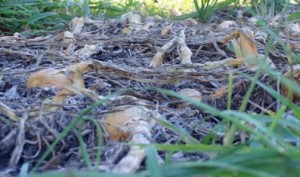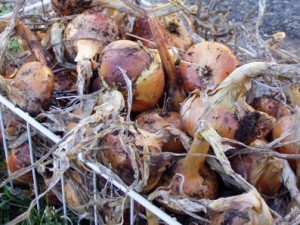 I know for many people, growing things in the garden is strictly done on the ‘what costs me a lot in the store’ aspect or ‘specialty things that I can’t get locally’ aspect. So, there are a lot of people who will grow 6 different varieties of heirloom tomatoes, but who won’t grow potatoes or onions because, after all, “I can buy a 50 pound bag at the store for $xx – it takes too much room to grow enough.” Or, “I don’t have room to store” or some other reason.
I know for many people, growing things in the garden is strictly done on the ‘what costs me a lot in the store’ aspect or ‘specialty things that I can’t get locally’ aspect. So, there are a lot of people who will grow 6 different varieties of heirloom tomatoes, but who won’t grow potatoes or onions because, after all, “I can buy a 50 pound bag at the store for $xx – it takes too much room to grow enough.” Or, “I don’t have room to store” or some other reason.
And Aunt Toby is here today to tell you this: It’s worth it.
First – you KNOW what you have in your soil. You KNOW what you did or didn’t do. You don’t have any control over what was done to the field that the potatoes or onions in that 50 pound bag came in, how they were handled, how they were cleaned and washed, how they were stored, how clean the equipment was that put the potatoes or onions into those bags. What the warehouse or the delivery truck was like. None of that is under your control when you buy that bag in the grocery store.
But when you grow your own, however much you grow, everything is YOU. How much compost you put into the soil, how closely you planted the onion or potato sets, how much you weeded to get rid of competition, how much you watered (because you had a dry summer) or didn’t. When you dug them up. How you dug them up. How you cleaned them. How you store them. It’s all you. And if you want to make sure of as many bites that go into your mouth (and into the tummies of the rest of your family), growing your own is the best way to do that.
Second – the return on investment (or as our ‘friends’ on Wall Street call it, “ROI”) for veggies like onions and potatoes is huge. I’ll use this year’s onion crop as an example:
This spring, we planted about one pound of yellow onion sets (we use yellow Stuttgarter onions because those are hard, dense onions and store really well; red onions are great fresh but they do not store well), in a space 4 feet by 12 feet, with each set spaced 6 inches apart. We just dug them up yesterday (we actually could have dug them up earlier; the foliage had flopped down and died back but we had some rainy weather and you don’t want to dig up your onions when it’s all wet – they get slimy). That one pound (give or take a few ounces; I’m not exactly sure if it was just one pound or a pound and a half) of sets turned into onions which weighed about 35 pounds (again, give or take a pound either way because the scale I was using is not really exact). Depending on where you live, your best storage onion might be something different; what grows best in any particular area is highly ‘day length’ specific. In the northern half of the US, yellow Stuttgarter is the storage onion of choice. Also, please note: just jogging down to your local home/garden store might not be the best place to buy your onion sets. First: If it’s a large national chain, your local store will have the same onion sets that everyone else in the chain gets and this might not be best for your area, truly. Second, the quality of storage might not be the best. It might be better to go to the mail order outlets or the internet to find onion sets – many outlets have varieties that will not be available in your local store and they will be shipped to you when the time is right for planting in any case. Just a thought.
 Again, let’s look at the numbers here:
Again, let’s look at the numbers here:
Est. 1.5 pounds of sets
Payback: 35 pounds of onions
The only cost we had was for the sets, a little bit of weeding time (we mulch heavily so that keeps most of the weeds in check) and some watering time during the dry spell. We also were using a hose from one of our sumps which basically runs no matter how dry it gets so we did not have any extra cost for electricity from the pump. The amount of space was 48 square feet.
There are other vegetables that take more work, but I think onions are worth it. One note: Once you’ve harvested your onions, sort through them. Anything that ends up smaller than a golfball, put back into the garden. This will overwinter and you’ve got a jumpstart for the next year. Anything that has a thick/green neck still (referred to as a ‘bull neck’), eat right away. These don’t keep well at all. Anything that still has any green foliage in the neck, also eat right away. Once you’ve sorted out what you want to store, wash them well and get all the dirt off them and spread them out on screens or in wire baskets (we use the wire baskets from an old freezer), in a breezy dry place to dry. Then store in mesh bags in a cool dark place.
Enjoy.
